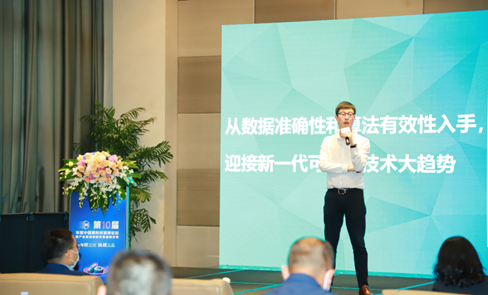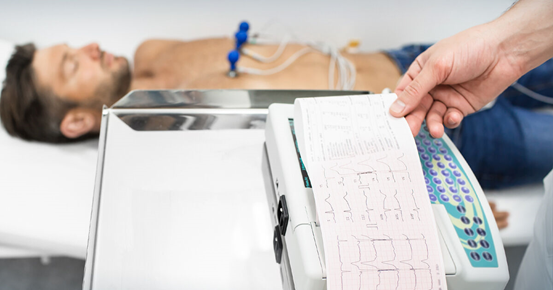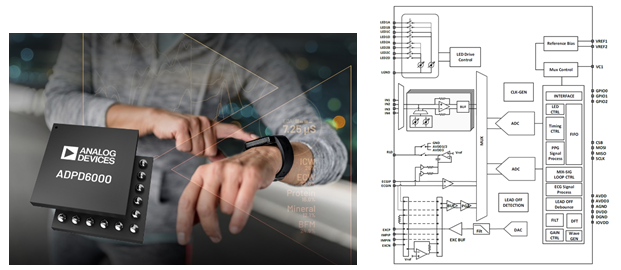Starting from data accuracy and algorithm effectiveness, the multi-modal vital signs monitoring front-end helps break the "involution" dilemma of wearable electronic products
Following smartphones, in recent years, wearable devices are "covering" the whole body and gradually become a new fashion for consumers: TWS headphones on the ears, smart bracelets/smart watches on the wrist, smart glasses/smart headsets on the head, and ECG monitors. T-shirts... A variety of smart wearable devices are becoming a new highlight in driving the growth of the consumer electronics market after mobile phones. But behind the seemingly prosperous appearance of a hundred flowers blooming, there are hidden worries in the development of wearable devices - single application scenarios, slow function updates, serious homogeneity, and many entrants...

He Yuan, senior market application manager of ADI China Product Division
“Bezos once said that many people pay attention to and pursue the things that will change in the next ten years, but he asks himself more about what will not change in the next ten years. From the perspective of wearable products, human beings’ concerns about health The pursuit is constant, and healthy consumption must be a major trend.” At the recent 10th Annual China Hard Technology Media Forum and Industry Chain Research and Innovation Trend Outlook Seminar, Senior Market Application Manager of ADI China Product Division. He Yuan said, “With the increase in the aging population and strong concerns about overall health care expenditures, out-of-hospital medical monitoring has become a development trend, monitoring patients with potential risks in daily life, or allowing patients to carry monitors by themselves. Wearable medical devices that can make the recovery process faster and more comfortable will become a necessity for people back home, and we have developed a new series of single-chip biomedical simulation front-ends to support customers around the world in meeting this trend."
Following the health trend, wearable devices break the impasse
Will wearable devices be destined to fall into the existing market and then fall into the dilemma of "involution"? Before answering this question, we might as well start from the nature of wearable devices and explore the core path of their development. A wearable device is a portable device that is worn directly on the body or integrated into the user's clothing or accessories. Wearable devices are not just hardware devices, but also achieve powerful functions through software support, data interaction, and cloud interaction. The current mainstream product forms of wearable devices include ear-worn devices supported by the ears, watches and bracelets supported by the wrist, and virtual reality/augmented reality devices supported by the head.
Wearable devices are more or less in partial contact with human body parts, so wearable products of any form can be used for health management and vital sign monitoring. “In fact, professional-grade wearable devices have long been widely used for monitoring and diagnostic purposes in the healthcare field, such as smart cloud blood pressure monitors, heart rate and blood oxygen detectors, remote monitoring devices (RPM), etc. Among commercial consumer-grade products, Health and medical care are also the main application scenarios and technology development trends of wrist devices. Many TWS headsets have been upgraded with heart rate monitoring functions. Even VR/AR devices that seem to have nothing to do with medical health can also be added by adding The sensor can detect and record the user's current health status in real time and provide professional advice," He Yuan pointed out.
As the core function of the development of wearable devices, the vital signs monitoring function is in line with the current policy environment and social needs: the "Healthy China 2030" Planning Outline issued by the Central Committee of the Communist Party of China and the State Council pointed out that it is necessary to develop Internet-based health services and cultivate A group of distinctive health management service industries explore and promote the development of wearable devices, smart health electronic products and health medical mobile application services; the "14th Five-Year Plan" National Aging Career Development and Elderly Care Service System Plan also focuses on research and development Wearable dynamic ECG monitoring equipment and other physiological parameter detection equipment, develop portable health monitoring equipment, self-service health detection equipment and other health monitoring products, develop new signal acquisition chips and intelligent digital medical terminals. Under the guidance of policies, the wearable device industry will enter a smooth road of rapid development.
According to the China Healthy Cities White Paper, people aged between 35 and 65 are becoming an army of chronic diseases. "Chronic diseases may sound very common, but they are very harmful, such as obesity, overweight, dyslipidemia, and fatty liver... These diseases are forming two trends: the incidence rate among the population is showing a clear upward trend; and the age of the affected people is changing. "Younger." He Yuan pointed out, "However, these chronic diseases will more or less show symptoms in advance. We can monitor these sub-health conditions to achieve early detection and timely treatment. This is the purpose of wearable medical devices. Huge opportunity.”
Starting from the "food theory" of health management, we build "trustworthy" wearable devices
Solutions related to vital signs on wearable devices currently mainly include three technologies: PPG (photoplethysmography), ECG (electrocardiogram), and Bio-z (bioimpedance analysis). PPG technology uses light as the main technical carrier, and is mostly used to obtain heart rate information. The photoelectric volume sensor can be used to obtain the PPG signal and measure the heart rate; ECG technology uses electricity as the main technical carrier, that is, electrocardiogram, which is also familiar to everyone in hospital examinations. Monitoring technology; Bio-z technology also uses electricity as the main technology carrier. It uses bioimpedance measurement to judge parameters such as body fat rate, basal metabolic rate, skeletal muscle, and water content. It can also be used for more accurate emotion measurement. .

The ideal measurement environment in the hospital can effectively ensure data accuracy
The above three technical measurements are all based on descriptions of ideal environments. For example, when performing ECG testing in a hospital, the temperature and humidity are appropriate, the state is stable, the equipment is complete, the time is sufficient, and there are professional doctors to analyze the body data, so it is easier to obtain stable measurement results in the hospital. "But if you move the same set of things to a wearable device on your wrist, various problems will arise." He Yuan analyzed, "The vital signs detection of wearable devices is greatly affected by various interference factors, and under different circumstances , The physical conditions of different people are different, such as whether the wearing is firm, surrounding electromagnetic interference, different skin conditions, light leakage, ambient light interference, dynamic light artifacts... These problems have greatly increased the difficulty of measurement of wearable devices. "

Just like ingredients and cooking skills are to gourmet food, the accuracy of data and the effectiveness of algorithms are indispensable for physical sign monitoring.
"To make wearable devices reliable enough, we need to focus on both data accuracy and algorithm optimization, just like cooking a delicious dish." He Yuan vividly gave an example, "Data is the ingredients, and the algorithm is the cooking skill. If you want to get Delicious food is indispensable both from the source and from exquisite cooking techniques. Accurate body sign signal collection can provide accurate data, and good modeling optimization algorithms can ensure the true restoration of body sign characteristics through data. "ADI in Semiconductors. Having been deeply involved in the field for decades, he has always focused on technologies such as analog and mixed signal processing. He has a deep accumulation in data acquisition, conversion, and analog/digital signal processing. The multi-mode vital sign monitoring sensor launched by ADI China Product Division The front-end ADPD6000 starts from these two aspects, not only focusing on data entry from the hardware circuit design, but also solving the above problems from the system level to the greatest extent through algorithm optimization.
A multi-pronged approach of software and hardware creates a trustworthy “expert account”
The ADPD6000 series is a highly integrated analog front end (AFE) designed for measuring various vital sign signals. It integrates multiple technologies such as ECG, PPG, and Bio-z and can be used for heart rate, ECG, blood oxygen, body fat, and emotion. and measurement of various parameters such as pressure.

ADPD6000 application and architecture diagram
The design of the optical path used for PPG is often quite difficult, because everyone is different in fat and thin, the tightness of the watch is different, and the skin color is different, including body hair, tattoos, scars and other factors that can affect the collection accuracy. In this regard, ADPD6000 provides an extremely high link signal-to-noise ratio, ensuring signal quality and measurable coverage, which can reduce measurement errors caused by common interference factors. It is also supplemented by ambient light suppression and dynamic interference suppression, striving to obtain Accurate and reliable data.
There are also many challenges in the ECG electrode part. "For example, the skin is dry in the cold winter, or the skin of older users is sagging. These are very common use cases and the results may not be measured in many cases." He Yuan pointed out, "ADI provides reliable, stable, and mature professional-level architecture technology. With the optimization of dry electrode test coverage, it can be adapted to more application scenarios. Even in dry winter, ADPD6000 can ensure sufficient measurement accuracy.”
Previous article:Want clinical-grade PPG for your wearable device? Just look here
Next article:To improve the wearing comfort of AR/VR headsets, Apple’s new patent can automatically adjust the display mode according to the parameters of the glasses clip.
Recommended ReadingLatest update time:2024-11-16 12:03

- e-Network Community and NXP launch Smart Space Building Automation Challenge
- The Internet of Things helps electric vehicle charging facilities move into the future
- Nordic Semiconductor Launches nRF54L15, nRF54L10 and nRF54L05 Next Generation Wireless SoCs
- Face detection based on camera capture video in OPENCV - Mir NXP i.MX93 development board
- The UK tests drones equipped with nervous systems: no need to frequently land for inspection
- The power of ultra-wideband: reshaping the automotive, mobile and industrial IoT experience
- STMicroelectronics launches highly adaptable and easy-to-connect dual-radio IoT module for metering and asset tracking applications
- This year, the number of IoT connections in my country is expected to exceed 3 billion
- Infineon Technologies SECORA™ Pay Bio Enhances Convenience and Trust in Contactless Biometric Payments
- Innolux's intelligent steer-by-wire solution makes cars smarter and safer
- 8051 MCU - Parity Check
- How to efficiently balance the sensitivity of tactile sensing interfaces
- What should I do if the servo motor shakes? What causes the servo motor to shake quickly?
- 【Brushless Motor】Analysis of three-phase BLDC motor and sharing of two popular development boards
- Midea Industrial Technology's subsidiaries Clou Electronics and Hekang New Energy jointly appeared at the Munich Battery Energy Storage Exhibition and Solar Energy Exhibition
- Guoxin Sichen | Application of ferroelectric memory PB85RS2MC in power battery management, with a capacity of 2M
- Analysis of common faults of frequency converter
- In a head-on competition with Qualcomm, what kind of cockpit products has Intel come up with?
- Dalian Rongke's all-vanadium liquid flow battery energy storage equipment industrialization project has entered the sprint stage before production
- Allegro MicroSystems Introduces Advanced Magnetic and Inductive Position Sensing Solutions at Electronica 2024
- Car key in the left hand, liveness detection radar in the right hand, UWB is imperative for cars!
- After a decade of rapid development, domestic CIS has entered the market
- Aegis Dagger Battery + Thor EM-i Super Hybrid, Geely New Energy has thrown out two "king bombs"
- A brief discussion on functional safety - fault, error, and failure
- In the smart car 2.0 cycle, these core industry chains are facing major opportunities!
- The United States and Japan are developing new batteries. CATL faces challenges? How should China's new energy battery industry respond?
- Murata launches high-precision 6-axis inertial sensor for automobiles
- Ford patents pre-charge alarm to help save costs and respond to emergencies
- New real-time microcontroller system from Texas Instruments enables smarter processing in automotive and industrial applications
- [Summary] EEWorld invites you to play disassembly (Part 2) - Multimeter, infrared thermometer
- Basic requirements for DSP to work properly
- Good news from Guoxin: Approved to acquire Japanese chip semiconductor lithography machine Pioneer Micro Technology
- LDO and LC filtering
- Ek314 How to upgrade Ubuntu 12.04 to 14.04?
- Develop Bluetooth devices from scratch
- Atmel A5 Development Board Hardware
- The scariest camera in history! Even thieves would cry when they see it...
- Embedded SBC plays AI reasoning
- Popular must-read! Can't these 20 amplifier Q&A selections help you solve your problems?



 New concept analog circuit 1-5
New concept analog circuit 1-5 \"New Concept Analog Circuit\" - Transistor [Text Version] (Yang Jianguo)
\"New Concept Analog Circuit\" - Transistor [Text Version] (Yang Jianguo)
















 京公网安备 11010802033920号
京公网安备 11010802033920号